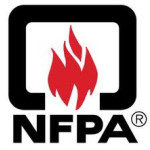- Industria: Fire safety
- Number of terms: 98780
- Number of blossaries: 0
- Company Profile:
Established in 1896, NFPA's mission is to reduce the worldwide burden of fire and other hazards on the quality of life by providing and advocating consensus codes and standards, research, training, and education.
A type of rope grab; auxiliary equipment; a friction or mechanical device utilized to allow ascending a fixed line.
Industry:Fire safety
A type of quick-response sprinkler that meets the criteria of 3. 6. 1(a)(1) and is listed for its capability to provide fire suppression of specific fire hazards.
Industry:Fire safety
A type of quick-response sprinkler that meets the criteria of 3. 6. 1(a)(1) of NFPA 13 and complies with the extended protection areas defined in Chapter 8 of NFPA 13.
Industry:Fire safety
A type of projector using 35-or 70-mm film that has a minimum width of 35 mm (13⁄8 in. ) and has on each edge 212 perforations per meter (5. 4 perforations per inch), or a type using carbon arc, xenon, or other light source equipment that develops hazardous gases, dust, or radiation.
Industry:Fire safety
A type of photoelectric light obscuration smoke detector wherein the beam spans the protected area.
Industry:Fire safety
A type of nonslip differential that operates automatically.
Industry:Fire safety
A type of multipurpose system utilizing a common piping system supplying domestic fixtures and fire sprinklers where each sprinkler is supplied by a minimum of three separate paths.
Industry:Fire safety
A type of fast-response sprinkler having a thermal element with an RTI of 50 (meters-seconds)1/2 or less, that has been specifically investigated for its ability to enhance survivability in the room of fire origin, and is listed for use in the protection of dwelling units.
Industry:Fire safety
A type of fast-response sprinkler that meets the criteria of 3. 6. 1(a)(1) and is listed for its capability to provide fire suppression of specific high-challenge fire hazards.
Industry:Fire safety
A type of defect found in welds that has a large length-to-width ratio and travels through or adjacent to the metal grain boundaries; usually, this type of defect is referred to as a crack.
Industry:Fire safety
